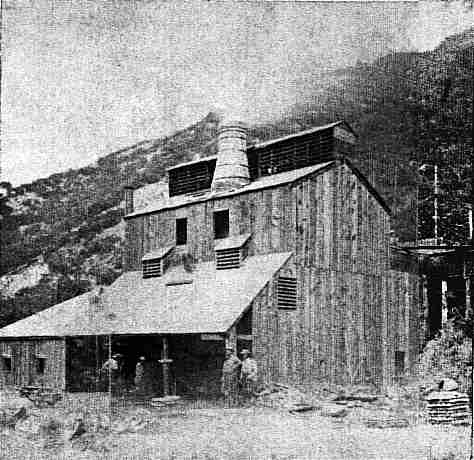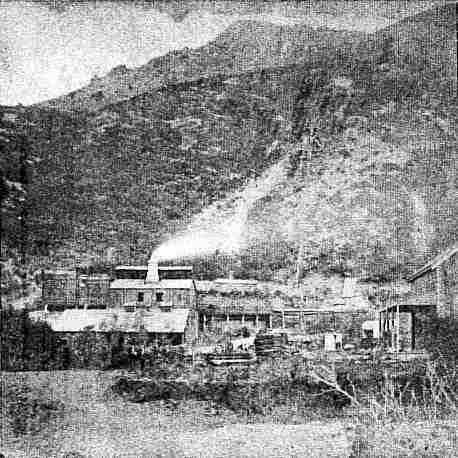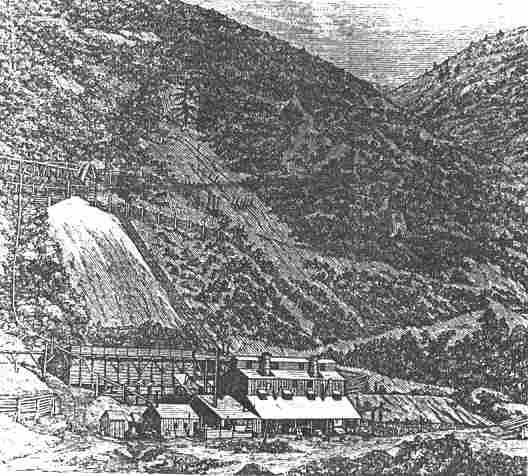Photographs by Charles Roscoe Savage, about 1871. From Stereo World, Vol. 21 No. 6, Jan/Feb 1995, p.16
Built by British investors, the Utah Smelter operated from 1871 to 1873. Though it was the first smelter in Bingham Canyon, where it was built because of its proximity to a steady supply of ore, it was far from a supply of fuel, which it consumed in great quantities, and the process of smelting was not perfected enough to prevent great losses of metal values into the slag and the air surrounding the smelter, meaning it suffered considerable financial losses during the brief period it operated. This smelter was built in Galena Gulch, near the Jordan Mine. Two other smelters were built in Bingham Canyon. They were were the Winamuck, 1871 to 1875 (shown below) and the Yampa, 1901 to 1909. Both of them were built in Bingham City near the railroad depot.
The Dutch-owned Winamuck Smelter operated in Bingham Canyon from 1871 to 1875.
-----o0o-----
The great Mormon Historian Andrew Jensen lived in Bingham Canyon and worked in a mine and a smelter for a few months during 1872. In the following account he describes his experiences:
In April [1872] I went to Bingham Canyon in search of work. Bingham was, as it is now, a mining town with the usual number of stores, hotels, boarding houses, gambling places and saloons, and was a lively though rather a tough place, with a mixed population. Here I had my first experience in working in a mine underground. I worked until the 3rd of May for $2.00 per day, boarding myself. My fellow-laborers were rough men, used to mining and I did not feel at home with them. I saw some rough life in Bingham. A certain Mr. Bennett, a big and burly fellow, challenged everyone in the camp to fight. He strutted about like a little king with a bell on, and like Goliath of old felt that no one dared to oppose him. Soon after I left the camp, however, he was killed by a man he had insulted.
While in that camp I learned thoroughly to mind my own business and to keep as far away as possible from those who quarreled and fought, and by so doing I did not suffer any abuse or insult worth mentioning. In the boarding house, where I also slept, 30 men or more took their meals. About two hundred men were employed in the mine in the vicinity of the upper smelter [the Utah] at the time I was there. I soon concluded to leave the hunters of precious metals to their choice of occupation, but as for myself I felt that the Lord had something better in life for me to do than hunting for gold. Still I have never regretted my experience in Bingham Canyon. I can always boast that once in my life I was a miner. On the 4th of May work was stopped in the mine where I worked because ventilation underground was poor and the air so foul that no one wished to risk his health by working there.
A few days later I succeeded in getting a job at a smelter [probably the Winamuck], which, by the way, was just as unhealthy and disagreeable as the underground work had been. It was not only unhealthy, but dirty and hard work as well. My working hours were in the night from 6:00 o'clock p.m. till 6:00 o'clock a.m. the next morning; the wages were three dollars per night. After working a few days, I began to feel ill and lost my appetite, which indicated that I was being poisoned gradually, yet I continued to work until the beginning of June, when the smelters closed up, as the furnaces froze, and work ceased until another oven could be built.
On Friday, June 7th, I left Bingham Canyon on foot to return to Pleasant Grove. By way of Herriman I reached the Jordan River which I forded and near the Point of the Mountain I reached a railroad camp which had been vacated a few days before. Being very tired, I entered one of the empty cabins and there enjoyed a good night's rest. The invigorating air on a pleasant summer night in the valley was very agreeable to me after my sojourn in the mountains where the weather was cold. I also had a most pleasant dream during the night, in which I seemed transferred to a most beautiful country, which was true in reality, for I had just left a corrupt mining camp, and was again about to associate with my own people whom I loved more than the gold and silver in the mountains. I reached Pleasant Grove the following day, June 8th [1872]. . . .
--Autobiography of Andrew Jensen, Deseret News Press, 1938, pp. 62-63.
To see a map of Galena Gulch, click here.
To see a map of Lower Bingham, click here.
To read a history of Bingham Canyon, click here.
To return to the Bingham Photo Album, click here.
To return to the Hickman Index page, click here.
.



